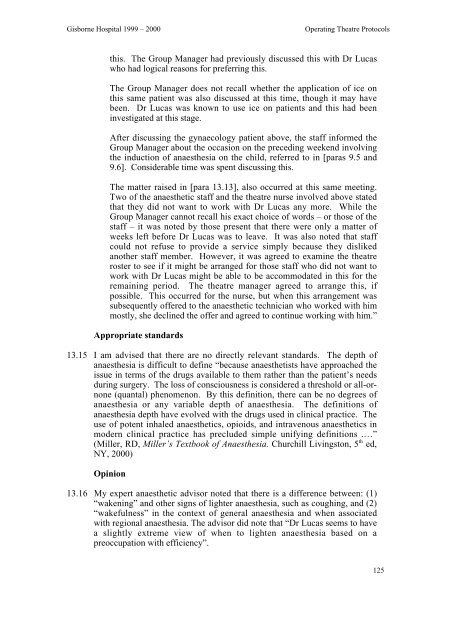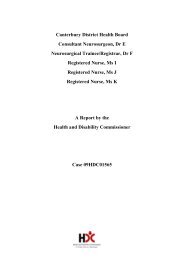Gisborne Hospital Report - Health and Disability Commissioner
Gisborne Hospital Report - Health and Disability Commissioner
Gisborne Hospital Report - Health and Disability Commissioner
You also want an ePaper? Increase the reach of your titles
YUMPU automatically turns print PDFs into web optimized ePapers that Google loves.
<strong>Gisborne</strong> <strong>Hospital</strong> 1999 – 2000<br />
Operating Theatre Protocols<br />
this. The Group Manager had previously discussed this with Dr Lucas<br />
who had logical reasons for preferring this.<br />
The Group Manager does not recall whether the application of ice on<br />
this same patient was also discussed at this time, though it may have<br />
been. Dr Lucas was known to use ice on patients <strong>and</strong> this had been<br />
investigated at this stage.<br />
After discussing the gynaecology patient above, the staff informed the<br />
Group Manager about the occasion on the preceding weekend involving<br />
the induction of anaesthesia on the child, referred to in [paras 9.5 <strong>and</strong><br />
9.6]. Considerable time was spent discussing this.<br />
The matter raised in [para 13.13], also occurred at this same meeting.<br />
Two of the anaesthetic staff <strong>and</strong> the theatre nurse involved above stated<br />
that they did not want to work with Dr Lucas any more. While the<br />
Group Manager cannot recall his exact choice of words – or those of the<br />
staff – it was noted by those present that there were only a matter of<br />
weeks left before Dr Lucas was to leave. It was also noted that staff<br />
could not refuse to provide a service simply because they disliked<br />
another staff member. However, it was agreed to examine the theatre<br />
roster to see if it might be arranged for those staff who did not want to<br />
work with Dr Lucas might be able to be accommodated in this for the<br />
remaining period. The theatre manager agreed to arrange this, if<br />
possible. This occurred for the nurse, but when this arrangement was<br />
subsequently offered to the anaesthetic technician who worked with him<br />
mostly, she declined the offer <strong>and</strong> agreed to continue working with him.”<br />
Appropriate st<strong>and</strong>ards<br />
13.15 I am advised that there are no directly relevant st<strong>and</strong>ards. The depth of<br />
anaesthesia is difficult to define “because anaesthetists have approached the<br />
issue in terms of the drugs available to them rather than the patient’s needs<br />
during surgery. The loss of consciousness is considered a threshold or all-ornone<br />
(quantal) phenomenon. By this definition, there can be no degrees of<br />
anaesthesia or any variable depth of anaesthesia. The definitions of<br />
anaesthesia depth have evolved with the drugs used in clinical practice. The<br />
use of potent inhaled anaesthetics, opioids, <strong>and</strong> intravenous anaesthetics in<br />
modern clinical practice has precluded simple unifying definitions .…”<br />
(Miller, RD, Miller’s Textbook of Anaesthesia. Churchill Livingston, 5 th ed,<br />
NY, 2000)<br />
Opinion<br />
13.16 My expert anaesthetic advisor noted that there is a difference between: (1)<br />
“wakening” <strong>and</strong> other signs of lighter anaesthesia, such as coughing, <strong>and</strong> (2)<br />
“wakefulness” in the context of general anaesthesia <strong>and</strong> when associated<br />
with regional anaesthesia. The advisor did note that “Dr Lucas seems to have<br />
a slightly extreme view of when to lighten anaesthesia based on a<br />
preoccupation with efficiency”.<br />
125
















